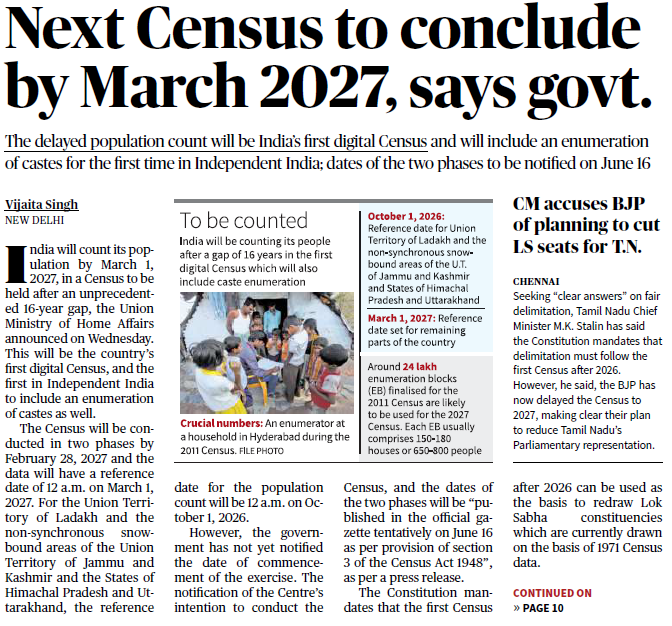
Source: The hindu
Relevant for: GS I (Society), GS II (Governance, Polity)
Why in News?
The Government of India has announced that the next Census—delayed since 2021—will be:
- Conducted digitally for the first time in India’s history.
- Completed by March 1, 2027, after a 16-year gap since the last Census in 2011.
- Include, for the first time in Independent India, an enumeration of caste.
- Census 2021 delayed: Due to the COVID-19 pandemic and administrative reasons, Census 2021 was postponed.
- Government announcement (June 2025):
- The Census will be completed by March 1, 2027.
- Will be India’s first fully digital Census.
- Will include caste enumeration — first time in Independent India (since 1931).
- Conducted in two phases, with reference dates:
- Oct 1, 2026 (for hilly/snowbound regions)
- March 1, 2027 (for the rest of the country)
WHY IMPORTANT
- Governance & Planning:
- Census forms the backbone of evidence-based policymaking, allocation of funds, and targeting of welfare schemes.
- Impacts redrawing of Lok Sabha and Assembly constituencies.
- Digital India push:
- Aligns with e-Governance initiatives and aims to ensure transparency and efficiency in data collection.
- Caste Enumeration:
- Could transform affirmative action policies, reservations, and social justice frameworks.
- Helps in understanding the demographic structure of OBCs and other communities.
- Significance of the Digital Census
- First ever digital: Data collection via mobile apps and tablets.
- Real-time syncing: Reduces errors, increases speed of processing.
- Reduced human error: More accurate and efficient than manual systems.
- Infrastructure challenge: Requires training, digital tools, internet access — especially in rural and remote areas.
- Caste Data Inclusion – A Paradigm Shift
- Historical gap: Last caste-based data collected in 1931 (except SC/ST).
- Positive Impact:
- Helps redesign welfare policies.
- Strengthens OBC upliftment programs.
- Risks:
- May lead to political polarisation.
- States may demand greater autonomy in classification and implementation.
- Governance & Administrative Concerns
- Delayed Census → policy vacuum:
- Schemes like NFSA, PMAY, MPLADS depend on population data.
- Affects parliamentary seat delimitation (especially for states like J&K).
- Disjointed timeline:
- Different reference dates for snowbound areas may create regional inconsistencies.
- Delayed Census → policy vacuum:
- Ethical, Legal & Privacy Issues
- Data security: Risk of breaches in sensitive caste and demographic information.
- Consent & awareness: Public needs confidence in non-misuse of data.
- Surveillance concern: Potential for misuse if adequate legal safeguards not implemented.
WAY FORWARD
- Strengthen legal framework:
- Enact or update data protection laws.
- Define clear guidelines on caste classification and usage of data.
- Public awareness & consent:
- Massive outreach campaigns to reduce suspicion and ensure participation.
- Robust infrastructure:
- Equip enumerators with digital tools.
- Ensure cybersecurity, especially in rural and remote belts.
- Stick to schedule:
- Notify phase dates (June 16) as planned to avoid further delays.
Which Constitutional provision mandates the holding of a Census in India at regular intervals?
A. Article 324
B. Article 280
C. None explicitly mentions Census
D. Article 82
Answer: C
There is no specific Article in the Constitution that mandates the Census. It is conducted under the Census Act, 1948, a legislation passed by Parliament.
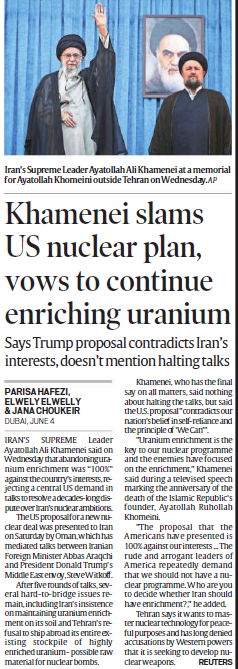
Why in News?
Iran’s Supreme Leader Ayatollah Ali Khamenei declared that Iran will continue enriching uranium and reject any US-proposed restrictions, reviving tensions over the Iran Nuclear Deal (JCPOA).
This follows the revival of a Trump-era proposal by the US aimed at curbing Iran’s nuclear activities in exchange for sanctions relief.
Background: JCPOA (Joint Comprehensive Plan of Action)
- Signed in 2015 between Iran and P5+1 (US, UK, France, Russia, China + Germany).
- Iran agreed to curb uranium enrichment; in return, sanctions were lifted.
- US withdrew in 2018 under President Trump, reimposing sanctions.
- Iran gradually breached JCPOA limits post-withdrawal.
Recent Developments (2025)
- The US is reviving old proposals to limit uranium enrichment.
- Khamenei:
- Rejected these proposals as against national interest.
- Asserted Iran’s right to peaceful nuclear technology.
- Did not rule out diplomatic engagement, but stood firm on enrichment policy.
Consider the following statements regarding the Joint Comprehensive Plan of Action (JCPOA):
- It was signed in 2015 between Iran and the P5+1 countries.
- The agreement allowed Iran to enrich uranium without restrictions.
- The United States withdrew from the JCPOA in 2018.
Which of the statements given above is/are correct?
A. 1 and 3 only
B. 2 and 3 only
C. 1 and 2 only
D. 1, 2 and 3
Answer: A
Statement 2 is incorrect because the JCPOA placed strict limits on uranium enrichment.
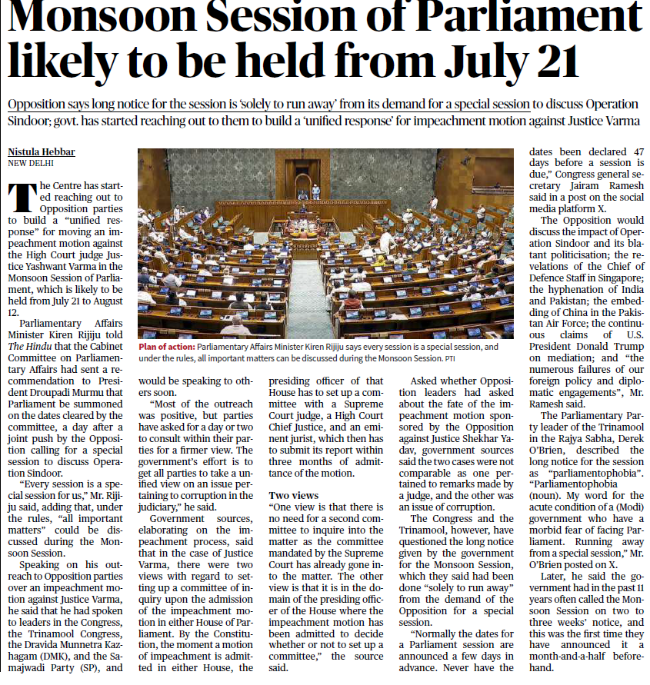
Why in News?
The Monsoon Session of Parliament is likely to be held from July 21 to August 12, 2025. It is expected to be stormy with the Opposition planning to raise issues such as Operation Sindoor and push for impeachment proceedings against a High Court judge.
- The Centre is reaching out to Opposition leaders to build a unified response for initiating impeachment proceedings against Justice Abhijit Varman, a High Court judge.
- The Monsoon Session may include debates on:
- Operation Sindoor controversy
- Indo-Pak relations
- Appointment of the Chief of Defence Staff (Singapore)
- Border issues with China
- Impact of US elections on India’s foreign policy
Parliamentary Procedure Involved:
- Impeachment process:
- Can be initiated in either House of Parliament.
- Upon admission of the motion, the Presiding Officer is required to form an investigation committee.
- A debate exists on whether an additional committee is required:
- One view: Existing rules suffice.
- Other view: Judiciary should internally manage such matters.
- Impeachment process:
Consider the following issues likely to be raised during the 2025 Monsoon Session of Parliament:
- Operation Sindoor
- Appointment of Singapore’s Chief of Defence Staff
- Border infrastructure development by China
- US Elections’ impact on India’s foreign policy
Which of the above are correctly mentioned in the news as expected discussion points?
A. 1 and 2 only
B. 1, 2 and 3 only
C. 1, 3 and 4 only
D. All of the above
Answer: D
Explanation: All four issues are explicitly mentioned in the article as likely to be raised during the Monsoon Session.
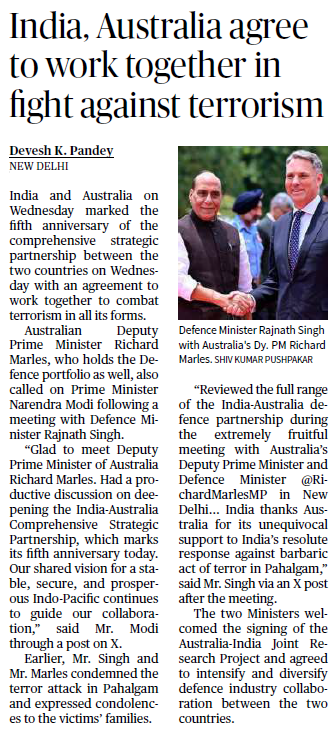
India and Australia marked the anniversary of their strategic partnership by reinforcing cooperation, especially in combating terrorism and enhancing defence ties.
- 🇮🇳 India-Australia Strategic Partnership: Reaffirmed mutual commitment to fight terrorism in all its forms.
High-Level Engagements:
- Australian Deputy PM & Defence Minister Richard Marles met with Indian Defence Minister Rajnath Singh and PM Narendra Modi.
Focus Areas:
- Defence cooperation
- Maritime security
- Counterterrorism
- Indo-Pacific regional stability
Quote:
“Reviewed the full range of India-Australia defence partnership and discussed enhancing it further.” – Rajnath Singh
Significance:
- Strengthens India’s Act East Policy
- Counters growing regional influence of China
- Supports rules-based Indo-Pacific order
Q. Select the correct answer using the code below:
Recently, India and Australia agreed to enhance cooperation in which of the following areas?
- Defence collaboration
- Maritime security
- Counterterrorism
- Outer space treaty development
A. 1 and 2 only
B. 1, 2, and 3 only
C. 2, 3, and 4 only
D. 1, 2, 3, and 4
Answer: B. 1, 2, and 3 only
Explanation:
India and Australia agreed to work together in defence, maritime security, and counterterrorism. There was no mention of cooperation in outer space treaty development in this meeting.

What’s the News?
- A new archaeological study reveals that Kutch in Gujarat was inhabited by hunter-gatherer communities over 5,000 years before the Harappan civilization.
- The discoveries reshape our understanding of prehistoric human evolution in Western India.
- Artifacts found: Shell scatters, stone tools, and settlement deposits.
- Scientific dating methods:
- Used Accelerator Mass Spectrometry (AMS) and Carbon-14 (C-14) techniques.
- Geographic site:
- Khadir Island in Kutch — now associated with Harappan city Dholavira.
- Subsistence pattern:
- Reliance on shellfish, marine species, and locally sourced tools.
- Ecology:
- Mangrove-dominated landscapes supported habitation.
Significance:
- Chronological Revision:
- Pushes human presence in Kutch thousands of years before Harappans (~2500 BCE).
- Cultural Continuity:
- Indicates gradual, indigenous cultural evolution—no evidence of sudden external influence.
- Early Innovations:
- Communities adapted to environmental challenges using local materials, possibly influencing Harappan planning.
- Relevance to Harappan Studies:
- Suggests Harappan civilization built upon local, pre-existing knowledge systems.
- Chronological Revision:
Q. Which of the statements is/are correct?
Consider the following statements regarding recent archaeological findings from the Kutch region:
- The findings suggest that the region was uninhabited prior to the Harappan civilization.
- Accelerator Mass Spectrometry was used to date the findings.
- The tools found indicate indigenous adaptation and gradual cultural evolution.
A. 1 and 2 only
B. 2 and 3 only
C. 1 and 3 only
D. 1, 2 and 3
Answer: B
Explanation:
- Statement 1 is incorrect – the study confirms habitation before Harappans.
- Statement 2 is correct – AMS was used for dating.
- Statement 3 is correct – tools and cultural traits indicate local evolution.
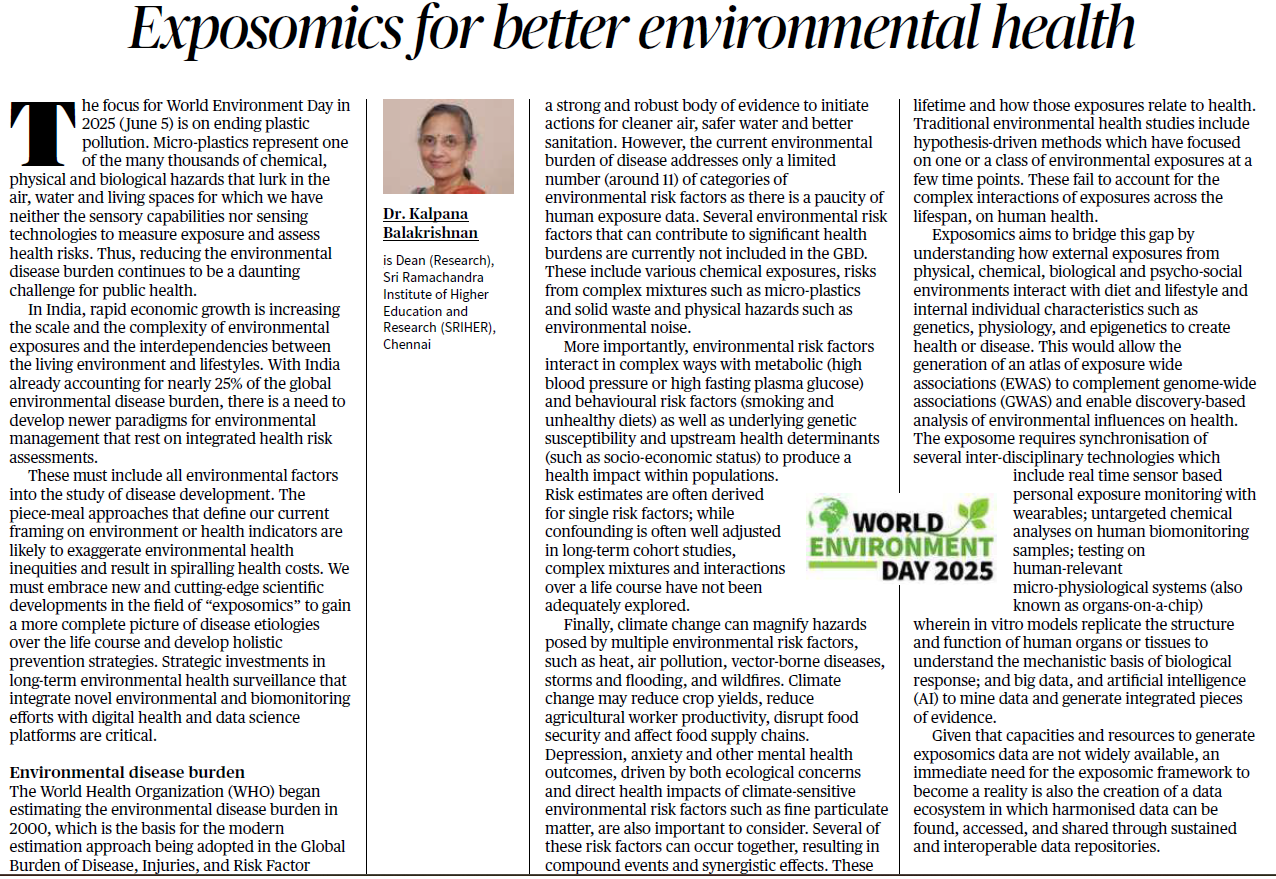
World Environment Day 2025 focuses on ending plastic pollution, highlighting broader challenges posed by chemical, physical, and biological hazards in our environment. The article emphasizes the growing need to adopt Exposomics as a scientific framework for understanding environmental health risks.
Exposomics is the study of the totality of environmental exposures across a person’s life and how these exposures interact with their biological systems.
Goal: To understand how environmental factors affect human health, especially in combination and over time.
Key Factors:
- Chemical (e.g., pollutants)
- Physical (e.g., microplastics)
- Biological (e.g., pathogens)
- Psycho-social (e.g., stress)
Current Challenges:
- Traditional methods are fragmented and hypothesis-driven, failing to capture complex exposure interactions.
- Data scarcity in Indian environmental health indicators.
- Lack of monitoring tools for microplastics, toxic air, and chemical residues.
India-Specific Relevance:
- India contributes 25% of global environmental disease burden.
- Urgent need for digital health surveillance platforms.
- Climate change is intensifying the effects of:
- Vector-borne diseases
- Respiratory conditions
- Water and food contamination
Technological Tools in Exposomics:
- Wearable exposure monitors
- Organ-on-a-chip systems (simulate human physiological responses)
- Untargeted chemical analysis
- Human-relevant models & big data analytics
- Genome-Wide Association Studies (GWAS)
- Environmental-Wide Association Studies (EWAS)
Q. What does the term Exposomics refer to?
A) The study of internal genetic mutations in a population
B) Analysis of fossil fuel emissions and their regulation
C) The study of all environmental exposures a person experiences and their impact on health
D) A new method of analyzing soil fertility for sustainable agriculture
Answer: C
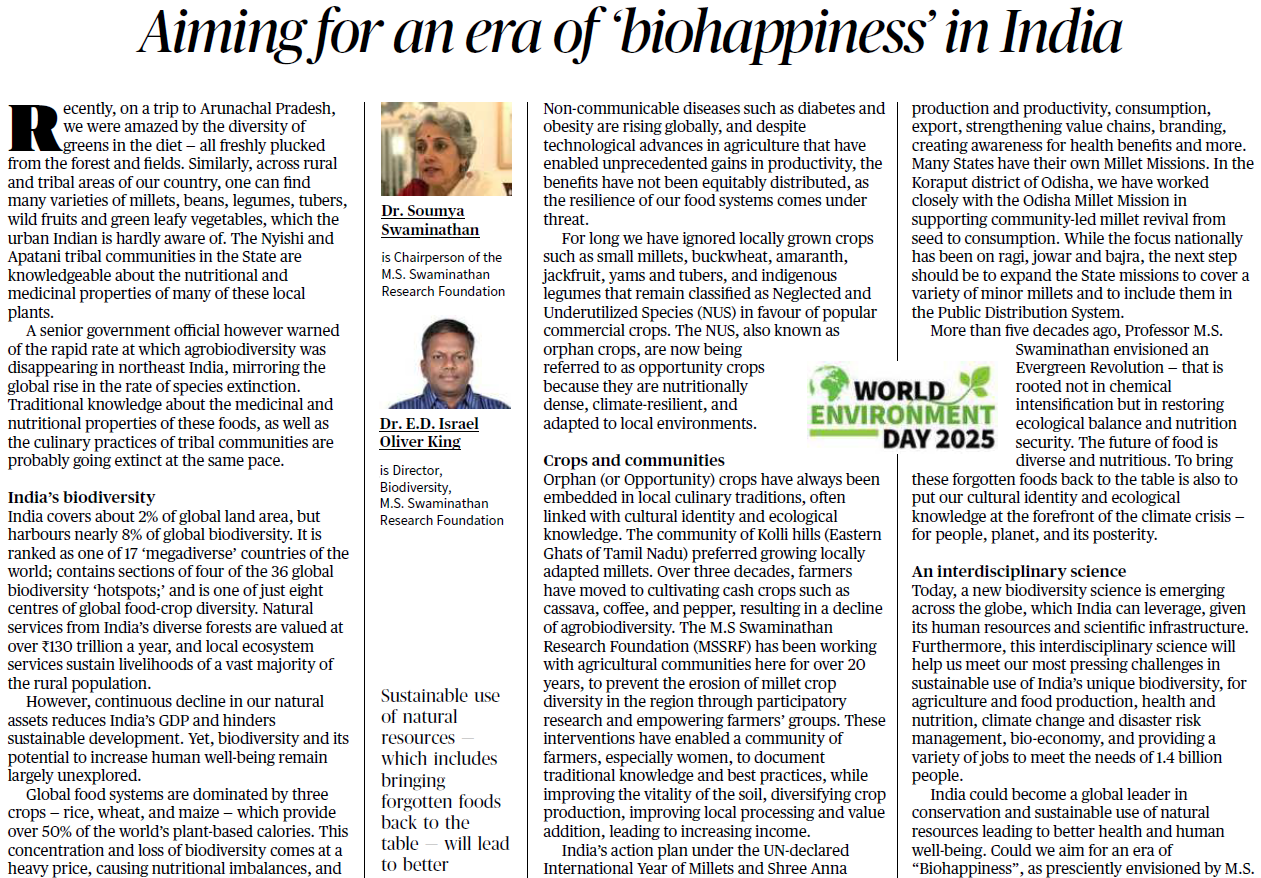
On the occasion of World Environment Day 2025, experts highlight the urgent need for India to leverage its rich agrobiodiversity, especially neglected and underutilized species (NUS), to achieve what is now being called “Biohappiness” a sustainable and inclusive approach to food, health, and ecological well-being.
Biohappiness:
- A term introduced by M.S. Swaminathan, focusing on happiness derived from the sustainable use of biodiversity.
- Promotes ecological balance, nutrition security, and rural development through diverse, traditional, and locally adapted crops.
India’s Biodiversity Landscape:
- India has ~8% of global biodiversity, with only 20% of land but hosts 4 of the 36 global biodiversity hotspots.
- Is one of 17 megadiverse countries, but faces rapid species extinction.
- Crops like millets, legumes, jackfruit, and tubers once dietary staples are underused despite high nutritional and climate resilience value.
Significance of NUS (Neglected and Underutilized Species):
- Examples: Small millets, pulses, yams, indigenous leafy greens, and tubers.
- Nutritionally dense, climate resilient, require fewer inputs, and well-suited to marginal ecosystems.
- Classified as ‘Orphan Crops’ rich in micronutrients, but ignored in mainstream agriculture and food systems.
Public Health & Food Security Linkage:
- Rising lifestyle diseases (diabetes, obesity) are linked to declining food diversity.
- Revival of traditional food systems improves both nutrition and livelihoods.
- Millet Missions in states like Odisha show how local food traditions can be revived for public distribution and welfare.
Biohappiness & Interdisciplinary Science:
A new biodiversity science, aligned with:
- Participatory breeding programs
- Agrobiodiversity mapping
- Biotechnology & food processing
- Community seed systems
- Climate-resilient agriculture
- Employment for rural youth and women through value-chain creation.
Global Role & Vision for India:
- India can lead globally in sustainable food systems using biodiversity.
- Support the International Year of Millets 2023 legacy.
- Link biodiversity to bio-economy, job creation, climate adaptation, and public health.
Q1. What is the main idea behind the term “Biohappiness”?
A) Emotional satisfaction from climate activism
B) Economic benefits from biofuels
C) Sustainable well-being through the use of biological resources and biodiversity
D) Conservation of animal species for ecological tourism
Answer: C
Biohappiness is a term coined by M.S. Swaminathan, referring to the happiness and well-being derived from the sustainable use of biodiversity including crops, medicinal plants, and natural ecosystems.
It emphasizes nutrition, ecological balance, and livelihood through the promotion of local, diverse, and traditional crops, especially those that are neglected and underutilized.
This concept is not about emotional satisfaction or eco-tourism, nor is it limited to biofuels or industrial bio-innovation.
Hence, Option C is the most accurate.
Q2. Which of the following crops are considered Neglected and Underutilized Species (NUS)?
- Sorghum
- Jackfruit
- Sweet potato
- Wheat
A) 1, 2 and 3 only
B) 2, 3 and 4 only
C) 1 and 4 only
D) All of the above
Answer: A
NUS (Neglected and Underutilized Species) refers to crops that are:
- Nutritionally valuable,
- Climate-resilient,
- Traditionally consumed in rural/tribal diets,
- Yet ignored by mainstream agriculture.
Included in NUS:
- Sorghum – A hardy millet, drought-resistant and nutritionally rich.
- Jackfruit – Indigenous, high-fiber, and often overlooked in national food systems.
- Sweet Potato – A root crop rich in vitamins; underutilized despite its nutritional value.
- Excluded from NUS:
- Wheat – A mainstream staple crop; widely cultivated and consumed globally. It does not fall under NUS, as it is already dominant in global agriculture. So, the correct answer is 1, 2 and 3 only
